Flu Pandemic: Impact, Challenges, and Role of Nurses
VerifiedAdded on 2022/11/24
|12
|3387
|367
AI Summary
This article discusses the impact of a flu pandemic, including its epidemiology and transmission. It also explores the role of nurses in pandemic emergencies and the challenges they face. Future directions and recommendations for addressing these challenges are provided.
Contribute Materials
Your contribution can guide someone’s learning journey. Share your
documents today.
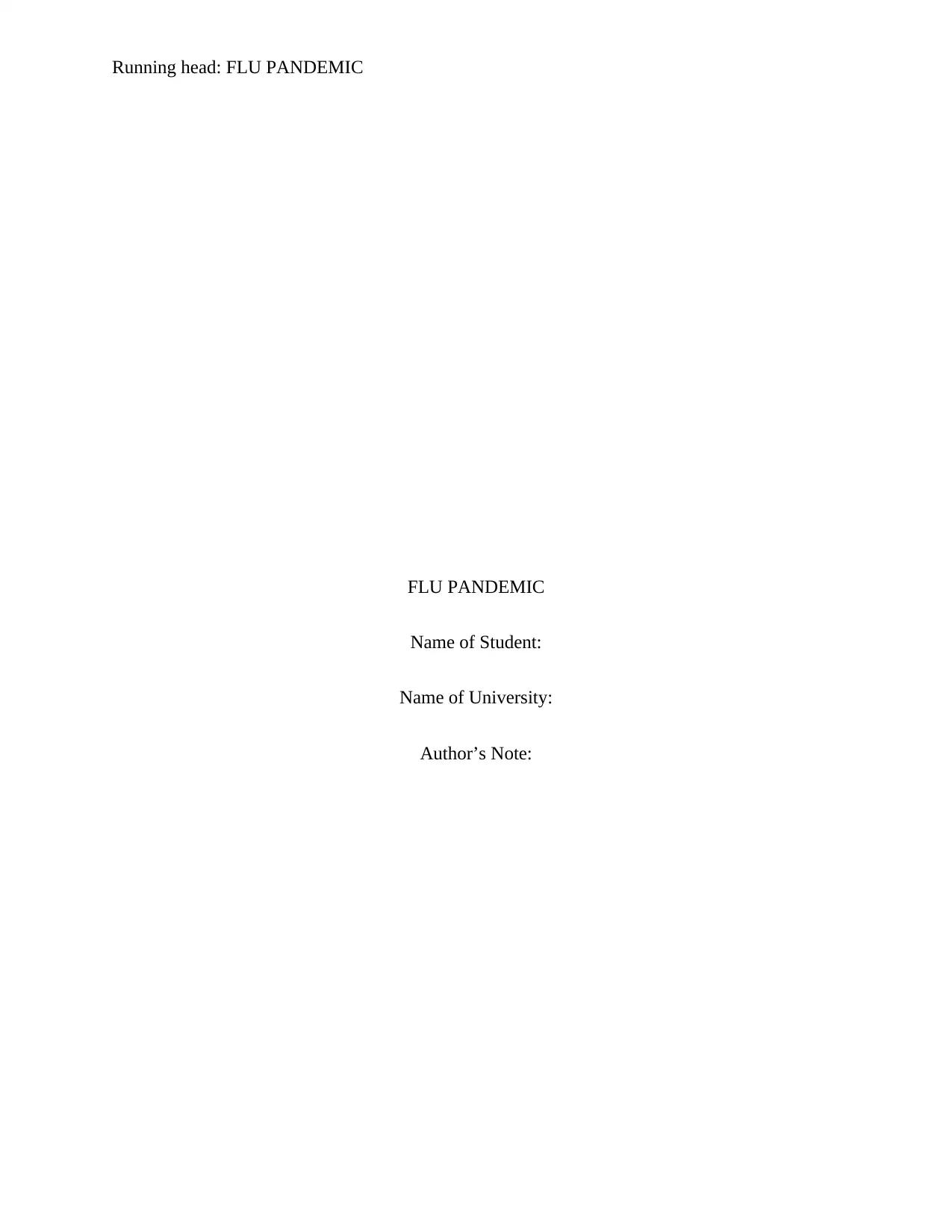
Running head: FLU PANDEMIC
FLU PANDEMIC
Name of Student:
Name of University:
Author’s Note:
FLU PANDEMIC
Name of Student:
Name of University:
Author’s Note:
Secure Best Marks with AI Grader
Need help grading? Try our AI Grader for instant feedback on your assignments.
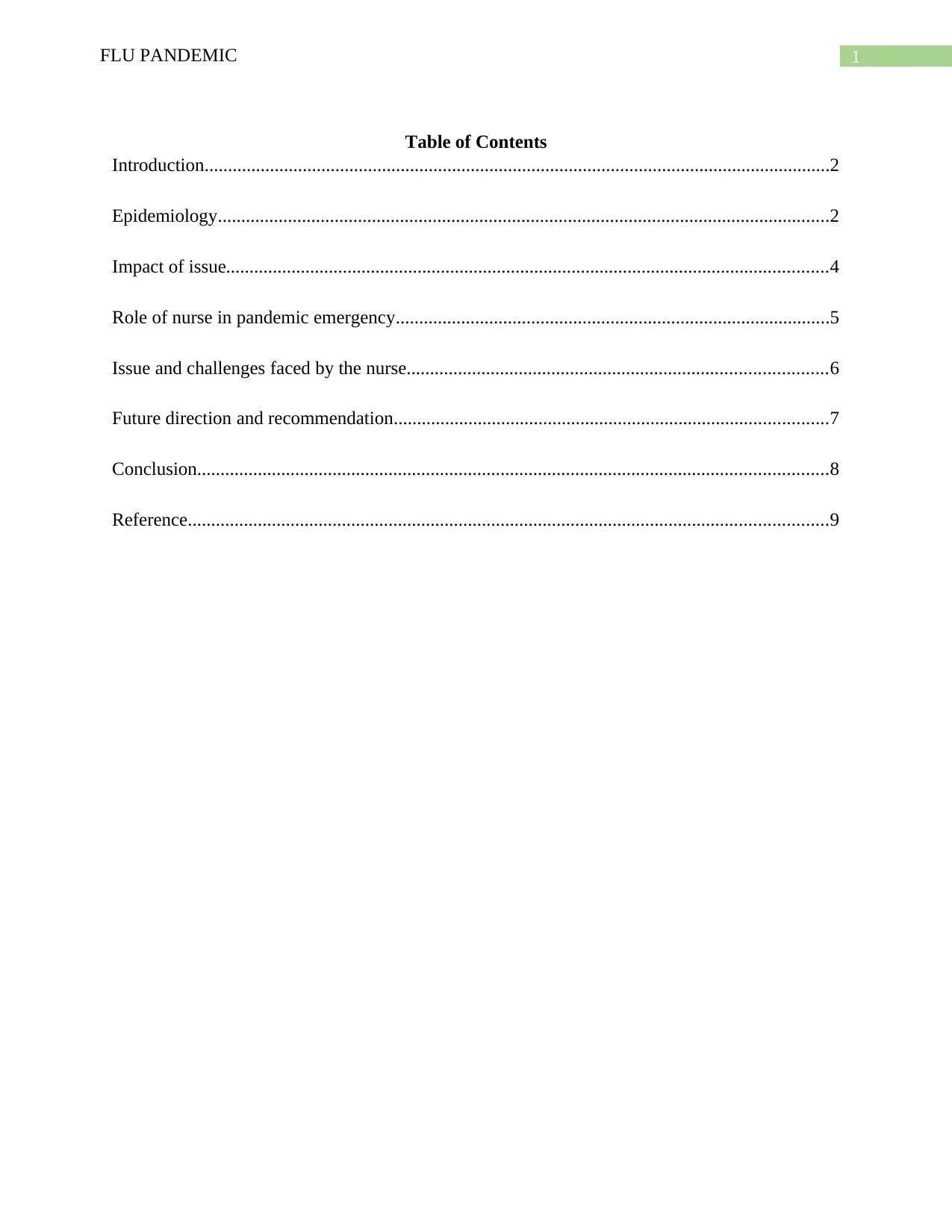
1FLU PANDEMIC
Table of Contents
Introduction......................................................................................................................................2
Epidemiology...................................................................................................................................2
Impact of issue.................................................................................................................................4
Role of nurse in pandemic emergency.............................................................................................5
Issue and challenges faced by the nurse..........................................................................................6
Future direction and recommendation.............................................................................................7
Conclusion.......................................................................................................................................8
Reference.........................................................................................................................................9
Table of Contents
Introduction......................................................................................................................................2
Epidemiology...................................................................................................................................2
Impact of issue.................................................................................................................................4
Role of nurse in pandemic emergency.............................................................................................5
Issue and challenges faced by the nurse..........................................................................................6
Future direction and recommendation.............................................................................................7
Conclusion.......................................................................................................................................8
Reference.........................................................................................................................................9
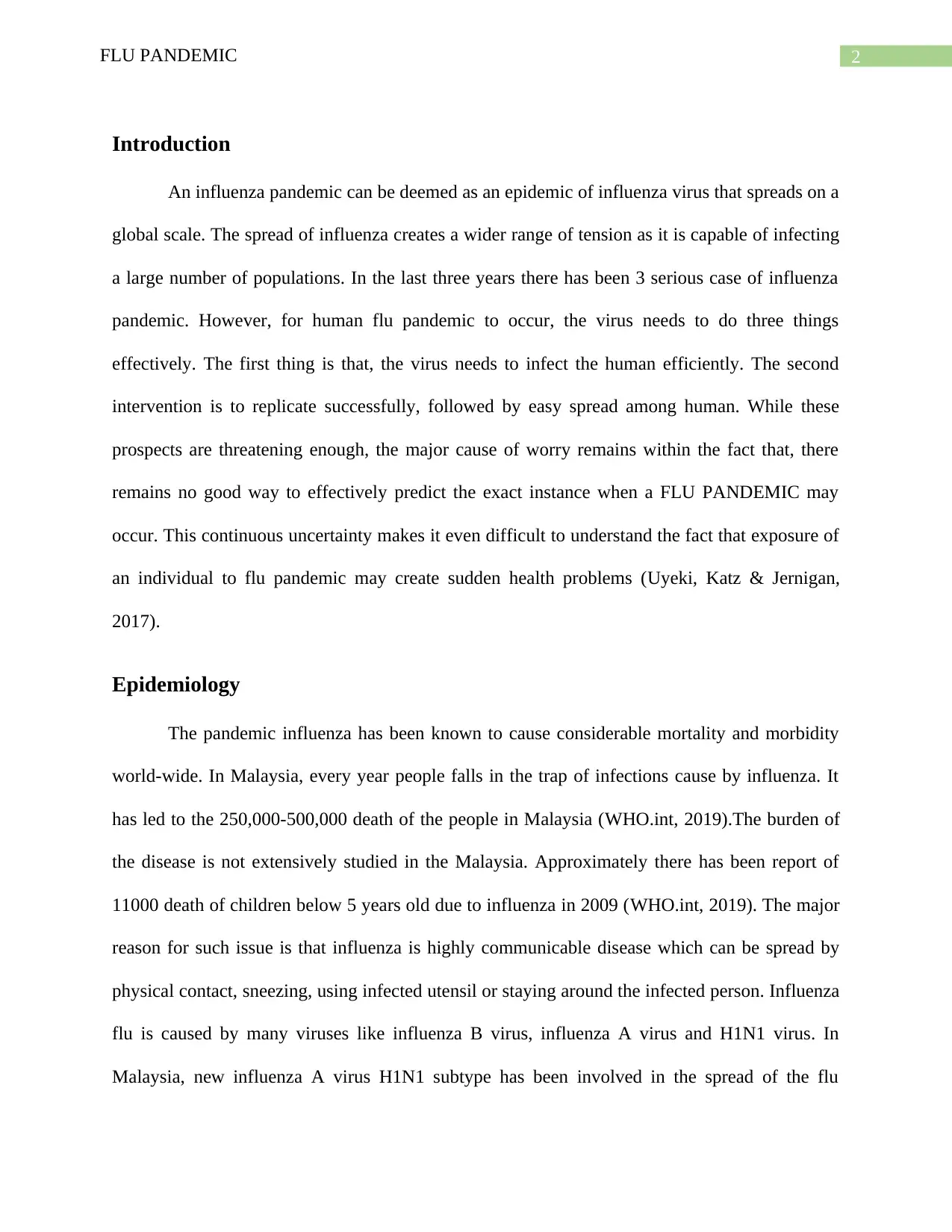
2FLU PANDEMIC
Introduction
An influenza pandemic can be deemed as an epidemic of influenza virus that spreads on a
global scale. The spread of influenza creates a wider range of tension as it is capable of infecting
a large number of populations. In the last three years there has been 3 serious case of influenza
pandemic. However, for human flu pandemic to occur, the virus needs to do three things
effectively. The first thing is that, the virus needs to infect the human efficiently. The second
intervention is to replicate successfully, followed by easy spread among human. While these
prospects are threatening enough, the major cause of worry remains within the fact that, there
remains no good way to effectively predict the exact instance when a FLU PANDEMIC may
occur. This continuous uncertainty makes it even difficult to understand the fact that exposure of
an individual to flu pandemic may create sudden health problems (Uyeki, Katz & Jernigan,
2017).
Epidemiology
The pandemic influenza has been known to cause considerable mortality and morbidity
world-wide. In Malaysia, every year people falls in the trap of infections cause by influenza. It
has led to the 250,000-500,000 death of the people in Malaysia (WHO.int, 2019).The burden of
the disease is not extensively studied in the Malaysia. Approximately there has been report of
11000 death of children below 5 years old due to influenza in 2009 (WHO.int, 2019). The major
reason for such issue is that influenza is highly communicable disease which can be spread by
physical contact, sneezing, using infected utensil or staying around the infected person. Influenza
flu is caused by many viruses like influenza B virus, influenza A virus and H1N1 virus. In
Malaysia, new influenza A virus H1N1 subtype has been involved in the spread of the flu
Introduction
An influenza pandemic can be deemed as an epidemic of influenza virus that spreads on a
global scale. The spread of influenza creates a wider range of tension as it is capable of infecting
a large number of populations. In the last three years there has been 3 serious case of influenza
pandemic. However, for human flu pandemic to occur, the virus needs to do three things
effectively. The first thing is that, the virus needs to infect the human efficiently. The second
intervention is to replicate successfully, followed by easy spread among human. While these
prospects are threatening enough, the major cause of worry remains within the fact that, there
remains no good way to effectively predict the exact instance when a FLU PANDEMIC may
occur. This continuous uncertainty makes it even difficult to understand the fact that exposure of
an individual to flu pandemic may create sudden health problems (Uyeki, Katz & Jernigan,
2017).
Epidemiology
The pandemic influenza has been known to cause considerable mortality and morbidity
world-wide. In Malaysia, every year people falls in the trap of infections cause by influenza. It
has led to the 250,000-500,000 death of the people in Malaysia (WHO.int, 2019).The burden of
the disease is not extensively studied in the Malaysia. Approximately there has been report of
11000 death of children below 5 years old due to influenza in 2009 (WHO.int, 2019). The major
reason for such issue is that influenza is highly communicable disease which can be spread by
physical contact, sneezing, using infected utensil or staying around the infected person. Influenza
flu is caused by many viruses like influenza B virus, influenza A virus and H1N1 virus. In
Malaysia, new influenza A virus H1N1 subtype has been involved in the spread of the flu
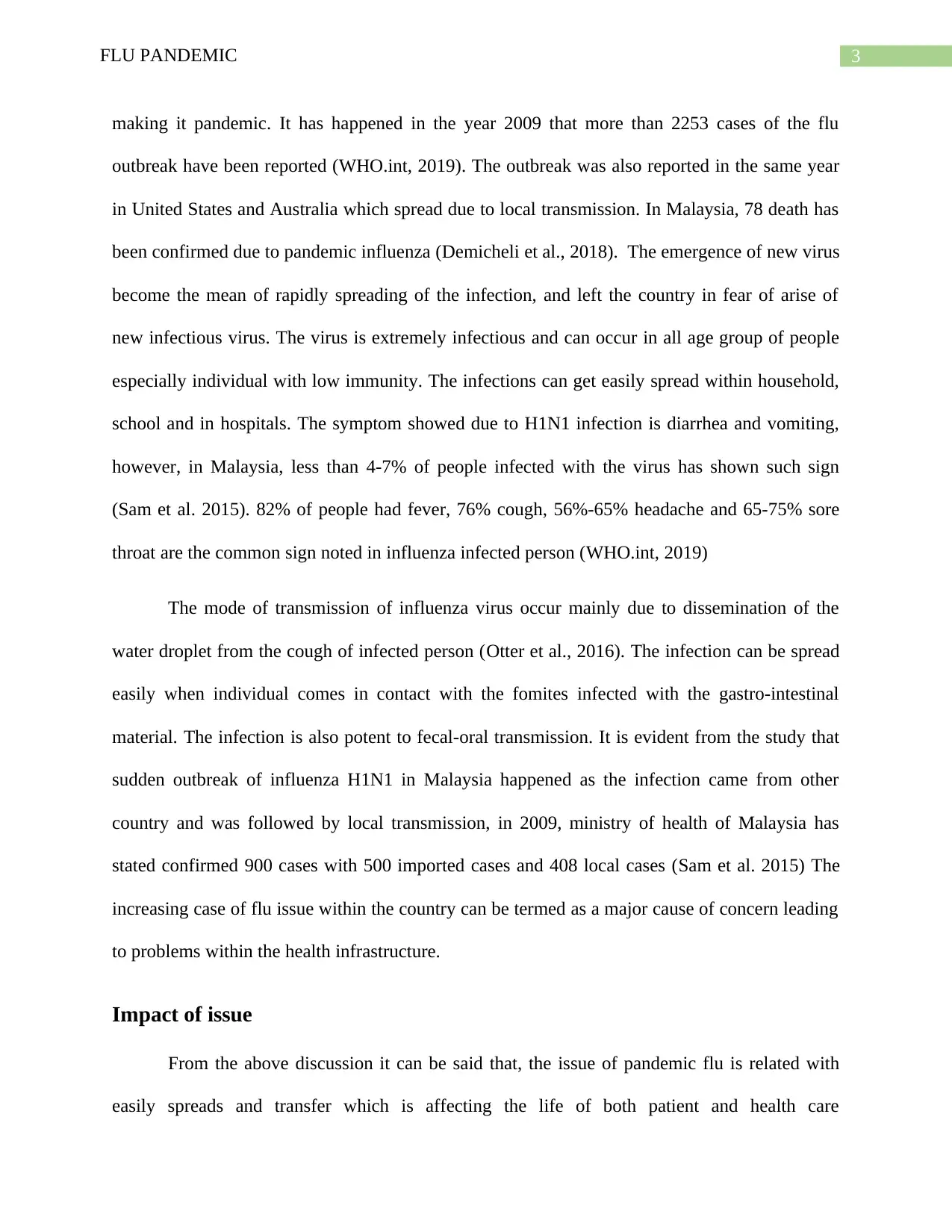
3FLU PANDEMIC
making it pandemic. It has happened in the year 2009 that more than 2253 cases of the flu
outbreak have been reported (WHO.int, 2019). The outbreak was also reported in the same year
in United States and Australia which spread due to local transmission. In Malaysia, 78 death has
been confirmed due to pandemic influenza (Demicheli et al., 2018). The emergence of new virus
become the mean of rapidly spreading of the infection, and left the country in fear of arise of
new infectious virus. The virus is extremely infectious and can occur in all age group of people
especially individual with low immunity. The infections can get easily spread within household,
school and in hospitals. The symptom showed due to H1N1 infection is diarrhea and vomiting,
however, in Malaysia, less than 4-7% of people infected with the virus has shown such sign
(Sam et al. 2015). 82% of people had fever, 76% cough, 56%-65% headache and 65-75% sore
throat are the common sign noted in influenza infected person (WHO.int, 2019)
The mode of transmission of influenza virus occur mainly due to dissemination of the
water droplet from the cough of infected person (Otter et al., 2016). The infection can be spread
easily when individual comes in contact with the fomites infected with the gastro-intestinal
material. The infection is also potent to fecal-oral transmission. It is evident from the study that
sudden outbreak of influenza H1N1 in Malaysia happened as the infection came from other
country and was followed by local transmission, in 2009, ministry of health of Malaysia has
stated confirmed 900 cases with 500 imported cases and 408 local cases (Sam et al. 2015) The
increasing case of flu issue within the country can be termed as a major cause of concern leading
to problems within the health infrastructure.
Impact of issue
From the above discussion it can be said that, the issue of pandemic flu is related with
easily spreads and transfer which is affecting the life of both patient and health care
making it pandemic. It has happened in the year 2009 that more than 2253 cases of the flu
outbreak have been reported (WHO.int, 2019). The outbreak was also reported in the same year
in United States and Australia which spread due to local transmission. In Malaysia, 78 death has
been confirmed due to pandemic influenza (Demicheli et al., 2018). The emergence of new virus
become the mean of rapidly spreading of the infection, and left the country in fear of arise of
new infectious virus. The virus is extremely infectious and can occur in all age group of people
especially individual with low immunity. The infections can get easily spread within household,
school and in hospitals. The symptom showed due to H1N1 infection is diarrhea and vomiting,
however, in Malaysia, less than 4-7% of people infected with the virus has shown such sign
(Sam et al. 2015). 82% of people had fever, 76% cough, 56%-65% headache and 65-75% sore
throat are the common sign noted in influenza infected person (WHO.int, 2019)
The mode of transmission of influenza virus occur mainly due to dissemination of the
water droplet from the cough of infected person (Otter et al., 2016). The infection can be spread
easily when individual comes in contact with the fomites infected with the gastro-intestinal
material. The infection is also potent to fecal-oral transmission. It is evident from the study that
sudden outbreak of influenza H1N1 in Malaysia happened as the infection came from other
country and was followed by local transmission, in 2009, ministry of health of Malaysia has
stated confirmed 900 cases with 500 imported cases and 408 local cases (Sam et al. 2015) The
increasing case of flu issue within the country can be termed as a major cause of concern leading
to problems within the health infrastructure.
Impact of issue
From the above discussion it can be said that, the issue of pandemic flu is related with
easily spreads and transfer which is affecting the life of both patient and health care
Secure Best Marks with AI Grader
Need help grading? Try our AI Grader for instant feedback on your assignments.
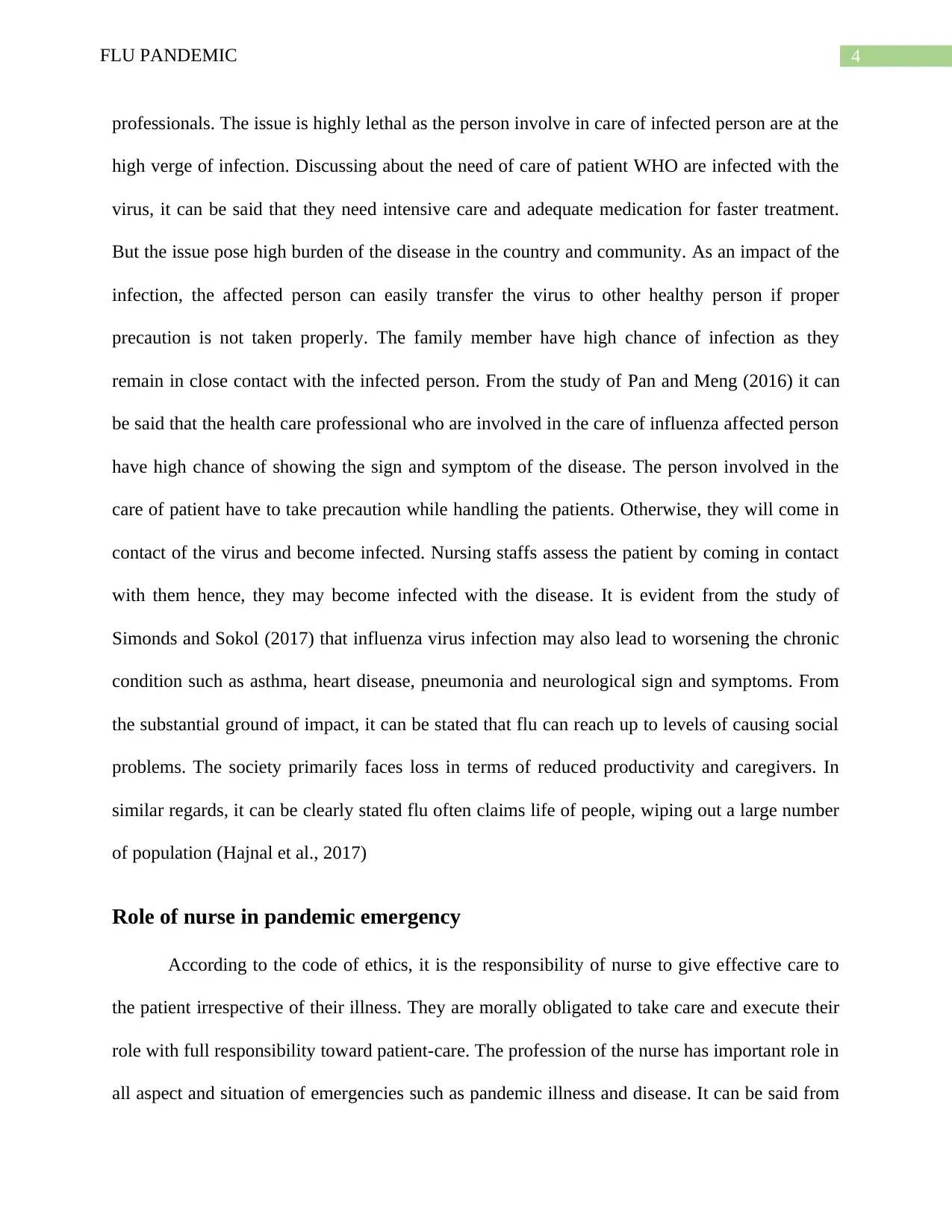
4FLU PANDEMIC
professionals. The issue is highly lethal as the person involve in care of infected person are at the
high verge of infection. Discussing about the need of care of patient WHO are infected with the
virus, it can be said that they need intensive care and adequate medication for faster treatment.
But the issue pose high burden of the disease in the country and community. As an impact of the
infection, the affected person can easily transfer the virus to other healthy person if proper
precaution is not taken properly. The family member have high chance of infection as they
remain in close contact with the infected person. From the study of Pan and Meng (2016) it can
be said that the health care professional who are involved in the care of influenza affected person
have high chance of showing the sign and symptom of the disease. The person involved in the
care of patient have to take precaution while handling the patients. Otherwise, they will come in
contact of the virus and become infected. Nursing staffs assess the patient by coming in contact
with them hence, they may become infected with the disease. It is evident from the study of
Simonds and Sokol (2017) that influenza virus infection may also lead to worsening the chronic
condition such as asthma, heart disease, pneumonia and neurological sign and symptoms. From
the substantial ground of impact, it can be stated that flu can reach up to levels of causing social
problems. The society primarily faces loss in terms of reduced productivity and caregivers. In
similar regards, it can be clearly stated flu often claims life of people, wiping out a large number
of population (Hajnal et al., 2017)
Role of nurse in pandemic emergency
According to the code of ethics, it is the responsibility of nurse to give effective care to
the patient irrespective of their illness. They are morally obligated to take care and execute their
role with full responsibility toward patient-care. The profession of the nurse has important role in
all aspect and situation of emergencies such as pandemic illness and disease. It can be said from
professionals. The issue is highly lethal as the person involve in care of infected person are at the
high verge of infection. Discussing about the need of care of patient WHO are infected with the
virus, it can be said that they need intensive care and adequate medication for faster treatment.
But the issue pose high burden of the disease in the country and community. As an impact of the
infection, the affected person can easily transfer the virus to other healthy person if proper
precaution is not taken properly. The family member have high chance of infection as they
remain in close contact with the infected person. From the study of Pan and Meng (2016) it can
be said that the health care professional who are involved in the care of influenza affected person
have high chance of showing the sign and symptom of the disease. The person involved in the
care of patient have to take precaution while handling the patients. Otherwise, they will come in
contact of the virus and become infected. Nursing staffs assess the patient by coming in contact
with them hence, they may become infected with the disease. It is evident from the study of
Simonds and Sokol (2017) that influenza virus infection may also lead to worsening the chronic
condition such as asthma, heart disease, pneumonia and neurological sign and symptoms. From
the substantial ground of impact, it can be stated that flu can reach up to levels of causing social
problems. The society primarily faces loss in terms of reduced productivity and caregivers. In
similar regards, it can be clearly stated flu often claims life of people, wiping out a large number
of population (Hajnal et al., 2017)
Role of nurse in pandemic emergency
According to the code of ethics, it is the responsibility of nurse to give effective care to
the patient irrespective of their illness. They are morally obligated to take care and execute their
role with full responsibility toward patient-care. The profession of the nurse has important role in
all aspect and situation of emergencies such as pandemic illness and disease. It can be said from
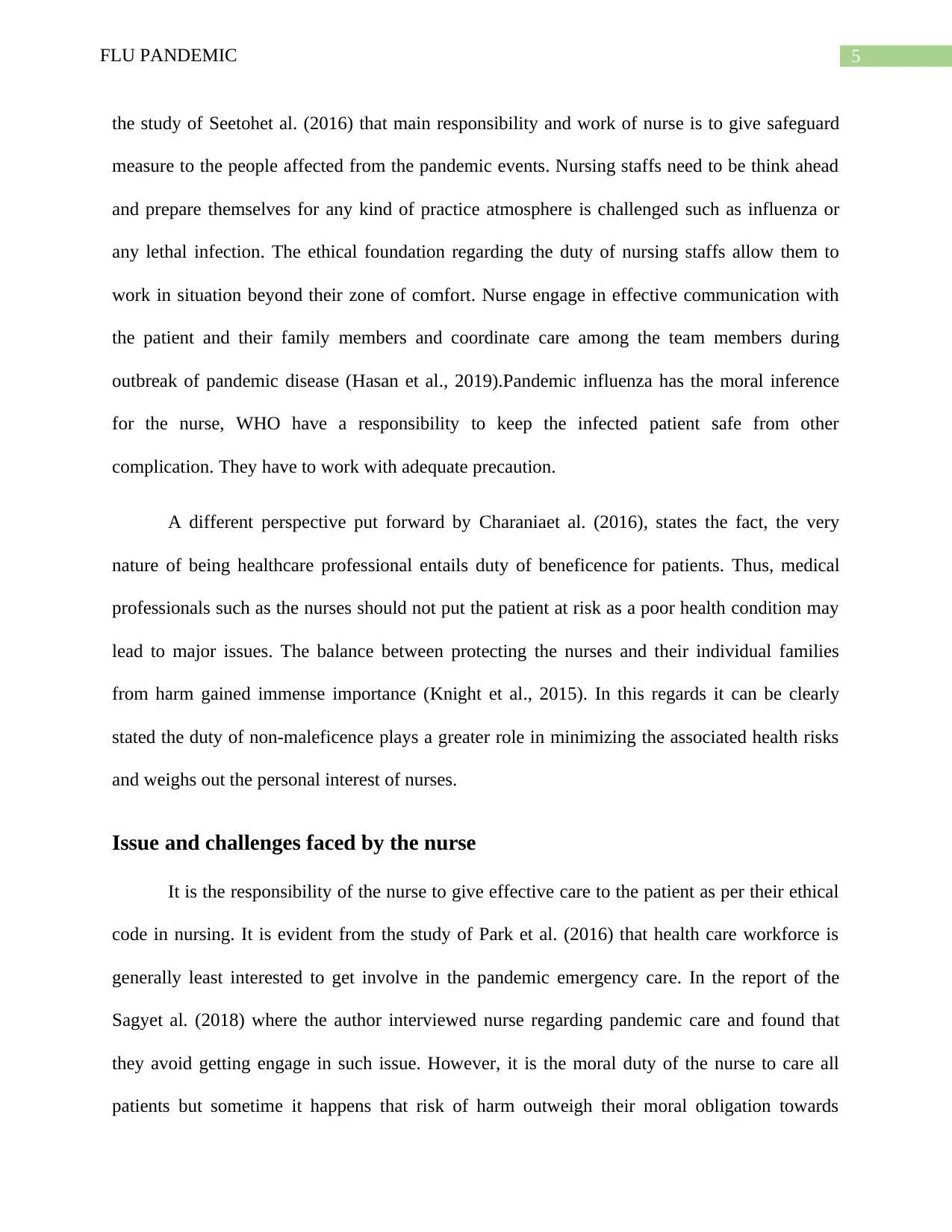
5FLU PANDEMIC
the study of Seetohet al. (2016) that main responsibility and work of nurse is to give safeguard
measure to the people affected from the pandemic events. Nursing staffs need to be think ahead
and prepare themselves for any kind of practice atmosphere is challenged such as influenza or
any lethal infection. The ethical foundation regarding the duty of nursing staffs allow them to
work in situation beyond their zone of comfort. Nurse engage in effective communication with
the patient and their family members and coordinate care among the team members during
outbreak of pandemic disease (Hasan et al., 2019).Pandemic influenza has the moral inference
for the nurse, WHO have a responsibility to keep the infected patient safe from other
complication. They have to work with adequate precaution.
A different perspective put forward by Charaniaet al. (2016), states the fact, the very
nature of being healthcare professional entails duty of beneficence for patients. Thus, medical
professionals such as the nurses should not put the patient at risk as a poor health condition may
lead to major issues. The balance between protecting the nurses and their individual families
from harm gained immense importance (Knight et al., 2015). In this regards it can be clearly
stated the duty of non-maleficence plays a greater role in minimizing the associated health risks
and weighs out the personal interest of nurses.
Issue and challenges faced by the nurse
It is the responsibility of the nurse to give effective care to the patient as per their ethical
code in nursing. It is evident from the study of Park et al. (2016) that health care workforce is
generally least interested to get involve in the pandemic emergency care. In the report of the
Sagyet al. (2018) where the author interviewed nurse regarding pandemic care and found that
they avoid getting engage in such issue. However, it is the moral duty of the nurse to care all
patients but sometime it happens that risk of harm outweigh their moral obligation towards
the study of Seetohet al. (2016) that main responsibility and work of nurse is to give safeguard
measure to the people affected from the pandemic events. Nursing staffs need to be think ahead
and prepare themselves for any kind of practice atmosphere is challenged such as influenza or
any lethal infection. The ethical foundation regarding the duty of nursing staffs allow them to
work in situation beyond their zone of comfort. Nurse engage in effective communication with
the patient and their family members and coordinate care among the team members during
outbreak of pandemic disease (Hasan et al., 2019).Pandemic influenza has the moral inference
for the nurse, WHO have a responsibility to keep the infected patient safe from other
complication. They have to work with adequate precaution.
A different perspective put forward by Charaniaet al. (2016), states the fact, the very
nature of being healthcare professional entails duty of beneficence for patients. Thus, medical
professionals such as the nurses should not put the patient at risk as a poor health condition may
lead to major issues. The balance between protecting the nurses and their individual families
from harm gained immense importance (Knight et al., 2015). In this regards it can be clearly
stated the duty of non-maleficence plays a greater role in minimizing the associated health risks
and weighs out the personal interest of nurses.
Issue and challenges faced by the nurse
It is the responsibility of the nurse to give effective care to the patient as per their ethical
code in nursing. It is evident from the study of Park et al. (2016) that health care workforce is
generally least interested to get involve in the pandemic emergency care. In the report of the
Sagyet al. (2018) where the author interviewed nurse regarding pandemic care and found that
they avoid getting engage in such issue. However, it is the moral duty of the nurse to care all
patients but sometime it happens that risk of harm outweigh their moral obligation towards

6FLU PANDEMIC
patients. The main factors in which such willingness depends among the nurses can be related
with health care facility, presence of safety equipment, provision of self-protection and presence
of vaccine along with anti-viral prophylactic agents against the flu.
Research of Dingwall (2017) have deal about various issues and challenges that nurse
face in preparing of pandemic emergency. Nurse are at high risk of infection of the disease as
they are in direct contact with the patient in their care. A san impact of the pandemic flu has
challenged the work and behavior of health care nurse. Nurse handle many type of patient in
pandemic emergency where some may be at high risk of infection of influenza. They are more
potent to spread the infection to the nurse. Nurse have to take many precautions while preparing
for pandemic emergency (Borgey et al., 2019). They need to maintain health hygiene to prevent
transmission of infection. Thus, the challenge has led them to work beyond their zone of
comfort.
Nurse and other health care staffs have to face inconsistent risk of exposure to the
influenza infection and fear of getting transmitted disease. In order to coordinate the work of
nurse with the need of patient, nurse have to cautiously take care of the infected person (Ofstead
et al., 2017). This is also the reason why nurse steps back as it become difficult of the nurse to
handle. It is evident from the research that major issue faced by nurse for not willing to work is
related with the risk of infection to themselves, their family and psychological stress
In preparedness of pandemic emergency, there is less likely that pharmaceutical
intervention like anti-viral and vaccine will be available. Such issue has led nurse to face the
challenge in giving effective care to the patients. In order to control the infection, there is many
pharmaceutical intervention such as vaccine and antiviral drugs to mitigate the issue. However,
Gavazzi (2019) reported that health sector limits the capacity of drug production. Deficiency of
patients. The main factors in which such willingness depends among the nurses can be related
with health care facility, presence of safety equipment, provision of self-protection and presence
of vaccine along with anti-viral prophylactic agents against the flu.
Research of Dingwall (2017) have deal about various issues and challenges that nurse
face in preparing of pandemic emergency. Nurse are at high risk of infection of the disease as
they are in direct contact with the patient in their care. A san impact of the pandemic flu has
challenged the work and behavior of health care nurse. Nurse handle many type of patient in
pandemic emergency where some may be at high risk of infection of influenza. They are more
potent to spread the infection to the nurse. Nurse have to take many precautions while preparing
for pandemic emergency (Borgey et al., 2019). They need to maintain health hygiene to prevent
transmission of infection. Thus, the challenge has led them to work beyond their zone of
comfort.
Nurse and other health care staffs have to face inconsistent risk of exposure to the
influenza infection and fear of getting transmitted disease. In order to coordinate the work of
nurse with the need of patient, nurse have to cautiously take care of the infected person (Ofstead
et al., 2017). This is also the reason why nurse steps back as it become difficult of the nurse to
handle. It is evident from the research that major issue faced by nurse for not willing to work is
related with the risk of infection to themselves, their family and psychological stress
In preparedness of pandemic emergency, there is less likely that pharmaceutical
intervention like anti-viral and vaccine will be available. Such issue has led nurse to face the
challenge in giving effective care to the patients. In order to control the infection, there is many
pharmaceutical intervention such as vaccine and antiviral drugs to mitigate the issue. However,
Gavazzi (2019) reported that health sector limits the capacity of drug production. Deficiency of
Paraphrase This Document
Need a fresh take? Get an instant paraphrase of this document with our AI Paraphraser

7FLU PANDEMIC
proper medication while preparing pandemic emergency is the other issue that nurse have to
face. Lack of vaccine and drug will put nurse more prone to infection.
Other challenge that nurse face in preparing pandemic emergency is
lack of efficient infrastructure. According to the study of Kaushalet al. (2019)
it can be said that in Malaysia there is lack of adequate number of bed, less
working staff which pose huge burden among the nurse. Nurses are not able
to prepare for the pandemic emergency because of lack of health care
resource (Borgey et al., 2019). There is no effective plan in health care
organization and definite protocol for the nurse that care of pandemic
patients. Due to this, they become vulnerable to infection. There is great
need to put forward certain rules and policy which will enhance their
personal safety.
Future direction and recommendation
From the study of Gravenstein et al. (2017) it was found that high number of nurse are
not willing to work with influenza infected person. It was further supported by the other study
and highlighted that in order to solve the issue and challenge that nurse face in pandemic
emergency, they need adequate training and education on infection control. By giving effective
education, will make nurse knowledgeable about the various control measure and precautions as
this will increase their inclination to work towards pandemic infection. To encounter such issue,
plan must be made with definite control measures, protocol and steps that focus to promote the
personal safety of nurse. Other recommendation can be made after reviewing the paper of
proper medication while preparing pandemic emergency is the other issue that nurse have to
face. Lack of vaccine and drug will put nurse more prone to infection.
Other challenge that nurse face in preparing pandemic emergency is
lack of efficient infrastructure. According to the study of Kaushalet al. (2019)
it can be said that in Malaysia there is lack of adequate number of bed, less
working staff which pose huge burden among the nurse. Nurses are not able
to prepare for the pandemic emergency because of lack of health care
resource (Borgey et al., 2019). There is no effective plan in health care
organization and definite protocol for the nurse that care of pandemic
patients. Due to this, they become vulnerable to infection. There is great
need to put forward certain rules and policy which will enhance their
personal safety.
Future direction and recommendation
From the study of Gravenstein et al. (2017) it was found that high number of nurse are
not willing to work with influenza infected person. It was further supported by the other study
and highlighted that in order to solve the issue and challenge that nurse face in pandemic
emergency, they need adequate training and education on infection control. By giving effective
education, will make nurse knowledgeable about the various control measure and precautions as
this will increase their inclination to work towards pandemic infection. To encounter such issue,
plan must be made with definite control measures, protocol and steps that focus to promote the
personal safety of nurse. Other recommendation can be made after reviewing the paper of
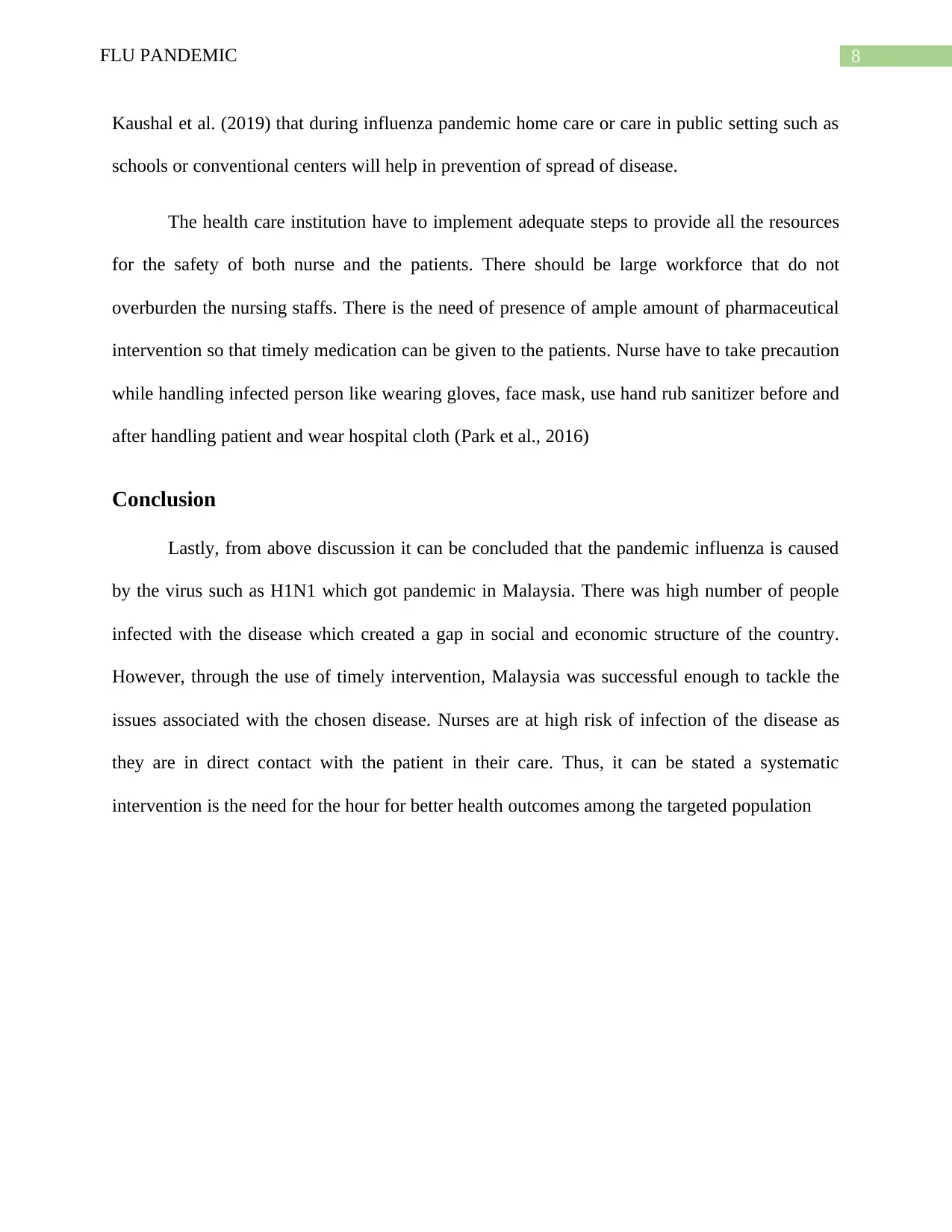
8FLU PANDEMIC
Kaushal et al. (2019) that during influenza pandemic home care or care in public setting such as
schools or conventional centers will help in prevention of spread of disease.
The health care institution have to implement adequate steps to provide all the resources
for the safety of both nurse and the patients. There should be large workforce that do not
overburden the nursing staffs. There is the need of presence of ample amount of pharmaceutical
intervention so that timely medication can be given to the patients. Nurse have to take precaution
while handling infected person like wearing gloves, face mask, use hand rub sanitizer before and
after handling patient and wear hospital cloth (Park et al., 2016)
Conclusion
Lastly, from above discussion it can be concluded that the pandemic influenza is caused
by the virus such as H1N1 which got pandemic in Malaysia. There was high number of people
infected with the disease which created a gap in social and economic structure of the country.
However, through the use of timely intervention, Malaysia was successful enough to tackle the
issues associated with the chosen disease. Nurses are at high risk of infection of the disease as
they are in direct contact with the patient in their care. Thus, it can be stated a systematic
intervention is the need for the hour for better health outcomes among the targeted population
Kaushal et al. (2019) that during influenza pandemic home care or care in public setting such as
schools or conventional centers will help in prevention of spread of disease.
The health care institution have to implement adequate steps to provide all the resources
for the safety of both nurse and the patients. There should be large workforce that do not
overburden the nursing staffs. There is the need of presence of ample amount of pharmaceutical
intervention so that timely medication can be given to the patients. Nurse have to take precaution
while handling infected person like wearing gloves, face mask, use hand rub sanitizer before and
after handling patient and wear hospital cloth (Park et al., 2016)
Conclusion
Lastly, from above discussion it can be concluded that the pandemic influenza is caused
by the virus such as H1N1 which got pandemic in Malaysia. There was high number of people
infected with the disease which created a gap in social and economic structure of the country.
However, through the use of timely intervention, Malaysia was successful enough to tackle the
issues associated with the chosen disease. Nurses are at high risk of infection of the disease as
they are in direct contact with the patient in their care. Thus, it can be stated a systematic
intervention is the need for the hour for better health outcomes among the targeted population
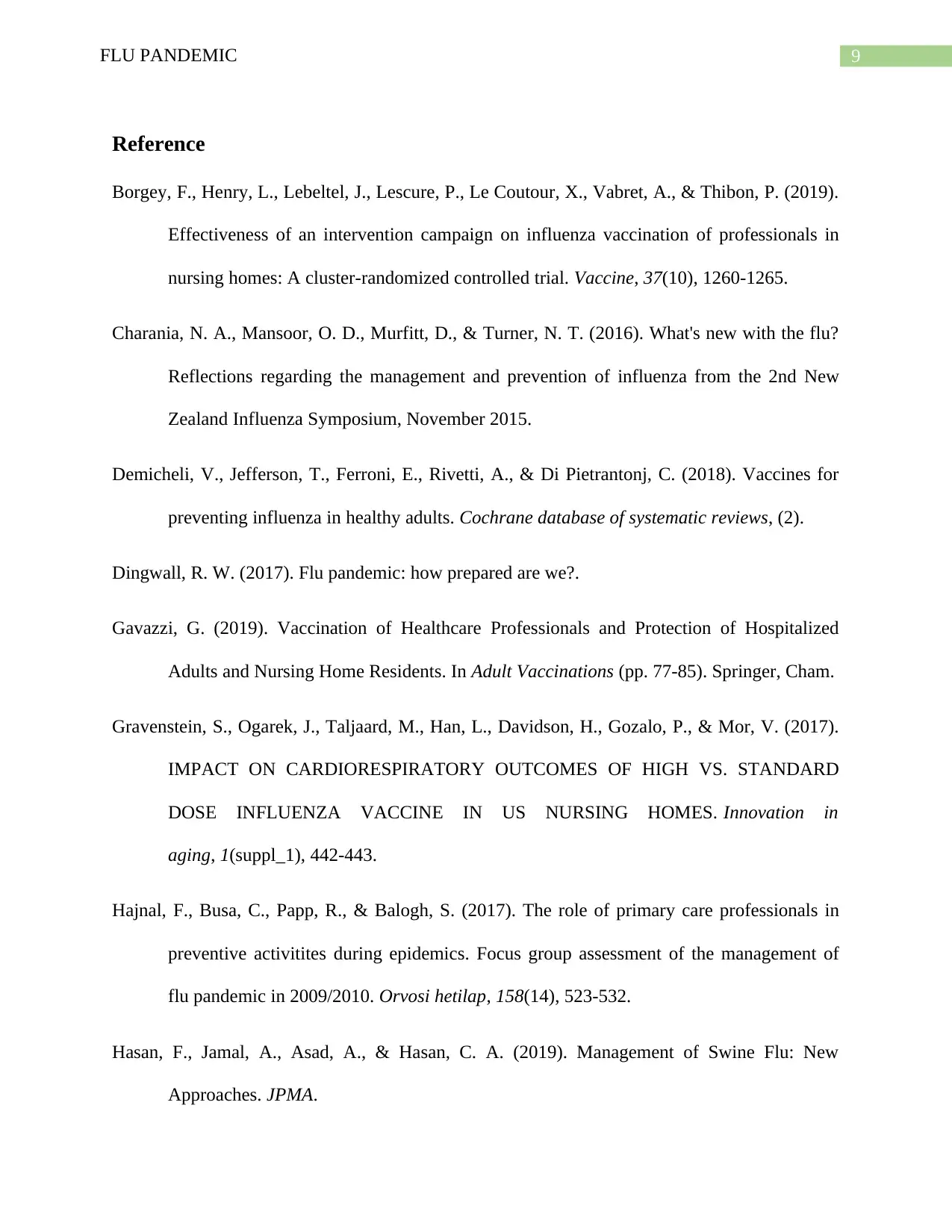
9FLU PANDEMIC
Reference
Borgey, F., Henry, L., Lebeltel, J., Lescure, P., Le Coutour, X., Vabret, A., & Thibon, P. (2019).
Effectiveness of an intervention campaign on influenza vaccination of professionals in
nursing homes: A cluster-randomized controlled trial. Vaccine, 37(10), 1260-1265.
Charania, N. A., Mansoor, O. D., Murfitt, D., & Turner, N. T. (2016). What's new with the flu?
Reflections regarding the management and prevention of influenza from the 2nd New
Zealand Influenza Symposium, November 2015.
Demicheli, V., Jefferson, T., Ferroni, E., Rivetti, A., & Di Pietrantonj, C. (2018). Vaccines for
preventing influenza in healthy adults. Cochrane database of systematic reviews, (2).
Dingwall, R. W. (2017). Flu pandemic: how prepared are we?.
Gavazzi, G. (2019). Vaccination of Healthcare Professionals and Protection of Hospitalized
Adults and Nursing Home Residents. In Adult Vaccinations (pp. 77-85). Springer, Cham.
Gravenstein, S., Ogarek, J., Taljaard, M., Han, L., Davidson, H., Gozalo, P., & Mor, V. (2017).
IMPACT ON CARDIORESPIRATORY OUTCOMES OF HIGH VS. STANDARD
DOSE INFLUENZA VACCINE IN US NURSING HOMES. Innovation in
aging, 1(suppl_1), 442-443.
Hajnal, F., Busa, C., Papp, R., & Balogh, S. (2017). The role of primary care professionals in
preventive activitites during epidemics. Focus group assessment of the management of
flu pandemic in 2009/2010. Orvosi hetilap, 158(14), 523-532.
Hasan, F., Jamal, A., Asad, A., & Hasan, C. A. (2019). Management of Swine Flu: New
Approaches. JPMA.
Reference
Borgey, F., Henry, L., Lebeltel, J., Lescure, P., Le Coutour, X., Vabret, A., & Thibon, P. (2019).
Effectiveness of an intervention campaign on influenza vaccination of professionals in
nursing homes: A cluster-randomized controlled trial. Vaccine, 37(10), 1260-1265.
Charania, N. A., Mansoor, O. D., Murfitt, D., & Turner, N. T. (2016). What's new with the flu?
Reflections regarding the management and prevention of influenza from the 2nd New
Zealand Influenza Symposium, November 2015.
Demicheli, V., Jefferson, T., Ferroni, E., Rivetti, A., & Di Pietrantonj, C. (2018). Vaccines for
preventing influenza in healthy adults. Cochrane database of systematic reviews, (2).
Dingwall, R. W. (2017). Flu pandemic: how prepared are we?.
Gavazzi, G. (2019). Vaccination of Healthcare Professionals and Protection of Hospitalized
Adults and Nursing Home Residents. In Adult Vaccinations (pp. 77-85). Springer, Cham.
Gravenstein, S., Ogarek, J., Taljaard, M., Han, L., Davidson, H., Gozalo, P., & Mor, V. (2017).
IMPACT ON CARDIORESPIRATORY OUTCOMES OF HIGH VS. STANDARD
DOSE INFLUENZA VACCINE IN US NURSING HOMES. Innovation in
aging, 1(suppl_1), 442-443.
Hajnal, F., Busa, C., Papp, R., & Balogh, S. (2017). The role of primary care professionals in
preventive activitites during epidemics. Focus group assessment of the management of
flu pandemic in 2009/2010. Orvosi hetilap, 158(14), 523-532.
Hasan, F., Jamal, A., Asad, A., & Hasan, C. A. (2019). Management of Swine Flu: New
Approaches. JPMA.
Secure Best Marks with AI Grader
Need help grading? Try our AI Grader for instant feedback on your assignments.
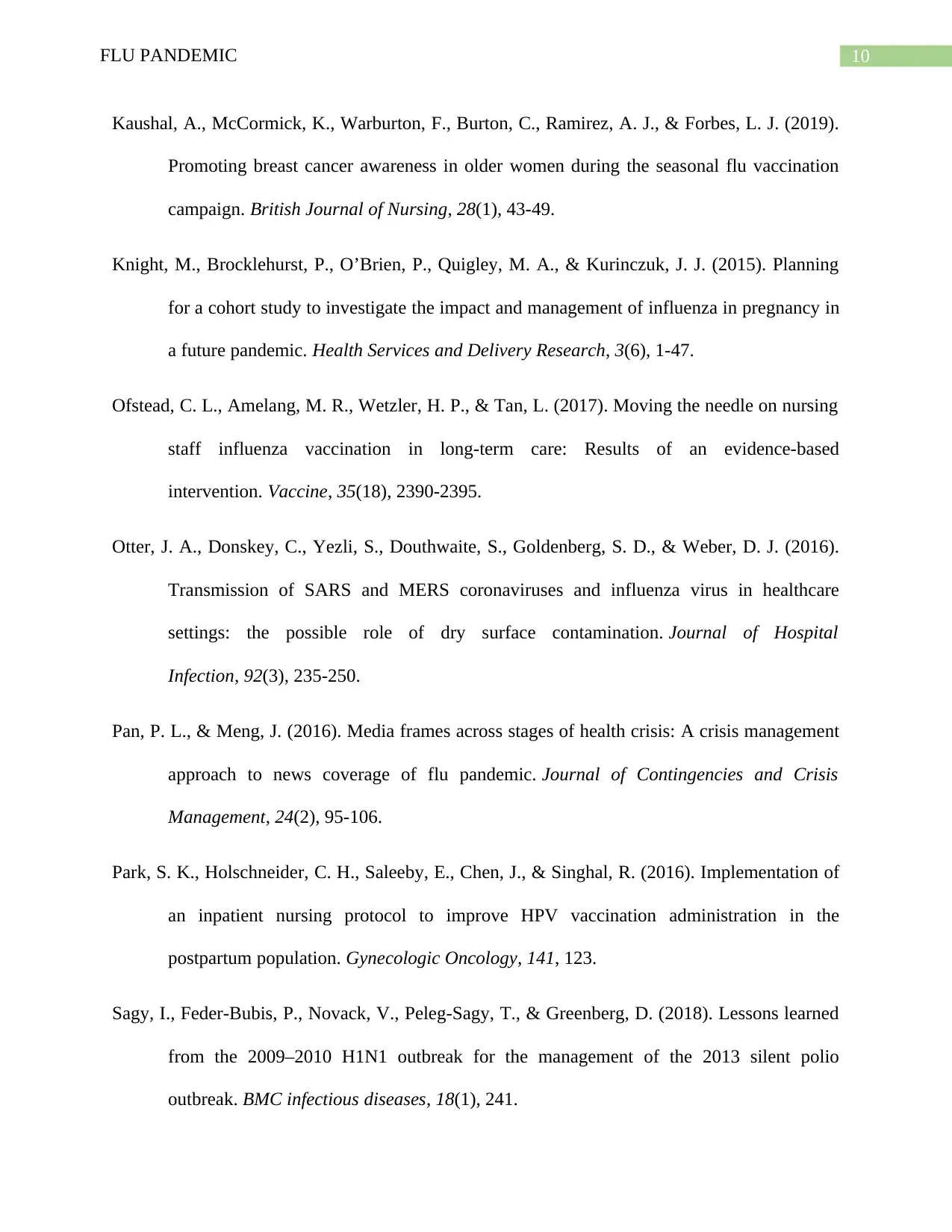
10FLU PANDEMIC
Kaushal, A., McCormick, K., Warburton, F., Burton, C., Ramirez, A. J., & Forbes, L. J. (2019).
Promoting breast cancer awareness in older women during the seasonal flu vaccination
campaign. British Journal of Nursing, 28(1), 43-49.
Knight, M., Brocklehurst, P., O’Brien, P., Quigley, M. A., & Kurinczuk, J. J. (2015). Planning
for a cohort study to investigate the impact and management of influenza in pregnancy in
a future pandemic. Health Services and Delivery Research, 3(6), 1-47.
Ofstead, C. L., Amelang, M. R., Wetzler, H. P., & Tan, L. (2017). Moving the needle on nursing
staff influenza vaccination in long-term care: Results of an evidence-based
intervention. Vaccine, 35(18), 2390-2395.
Otter, J. A., Donskey, C., Yezli, S., Douthwaite, S., Goldenberg, S. D., & Weber, D. J. (2016).
Transmission of SARS and MERS coronaviruses and influenza virus in healthcare
settings: the possible role of dry surface contamination. Journal of Hospital
Infection, 92(3), 235-250.
Pan, P. L., & Meng, J. (2016). Media frames across stages of health crisis: A crisis management
approach to news coverage of flu pandemic. Journal of Contingencies and Crisis
Management, 24(2), 95-106.
Park, S. K., Holschneider, C. H., Saleeby, E., Chen, J., & Singhal, R. (2016). Implementation of
an inpatient nursing protocol to improve HPV vaccination administration in the
postpartum population. Gynecologic Oncology, 141, 123.
Sagy, I., Feder-Bubis, P., Novack, V., Peleg-Sagy, T., & Greenberg, D. (2018). Lessons learned
from the 2009–2010 H1N1 outbreak for the management of the 2013 silent polio
outbreak. BMC infectious diseases, 18(1), 241.
Kaushal, A., McCormick, K., Warburton, F., Burton, C., Ramirez, A. J., & Forbes, L. J. (2019).
Promoting breast cancer awareness in older women during the seasonal flu vaccination
campaign. British Journal of Nursing, 28(1), 43-49.
Knight, M., Brocklehurst, P., O’Brien, P., Quigley, M. A., & Kurinczuk, J. J. (2015). Planning
for a cohort study to investigate the impact and management of influenza in pregnancy in
a future pandemic. Health Services and Delivery Research, 3(6), 1-47.
Ofstead, C. L., Amelang, M. R., Wetzler, H. P., & Tan, L. (2017). Moving the needle on nursing
staff influenza vaccination in long-term care: Results of an evidence-based
intervention. Vaccine, 35(18), 2390-2395.
Otter, J. A., Donskey, C., Yezli, S., Douthwaite, S., Goldenberg, S. D., & Weber, D. J. (2016).
Transmission of SARS and MERS coronaviruses and influenza virus in healthcare
settings: the possible role of dry surface contamination. Journal of Hospital
Infection, 92(3), 235-250.
Pan, P. L., & Meng, J. (2016). Media frames across stages of health crisis: A crisis management
approach to news coverage of flu pandemic. Journal of Contingencies and Crisis
Management, 24(2), 95-106.
Park, S. K., Holschneider, C. H., Saleeby, E., Chen, J., & Singhal, R. (2016). Implementation of
an inpatient nursing protocol to improve HPV vaccination administration in the
postpartum population. Gynecologic Oncology, 141, 123.
Sagy, I., Feder-Bubis, P., Novack, V., Peleg-Sagy, T., & Greenberg, D. (2018). Lessons learned
from the 2009–2010 H1N1 outbreak for the management of the 2013 silent polio
outbreak. BMC infectious diseases, 18(1), 241.
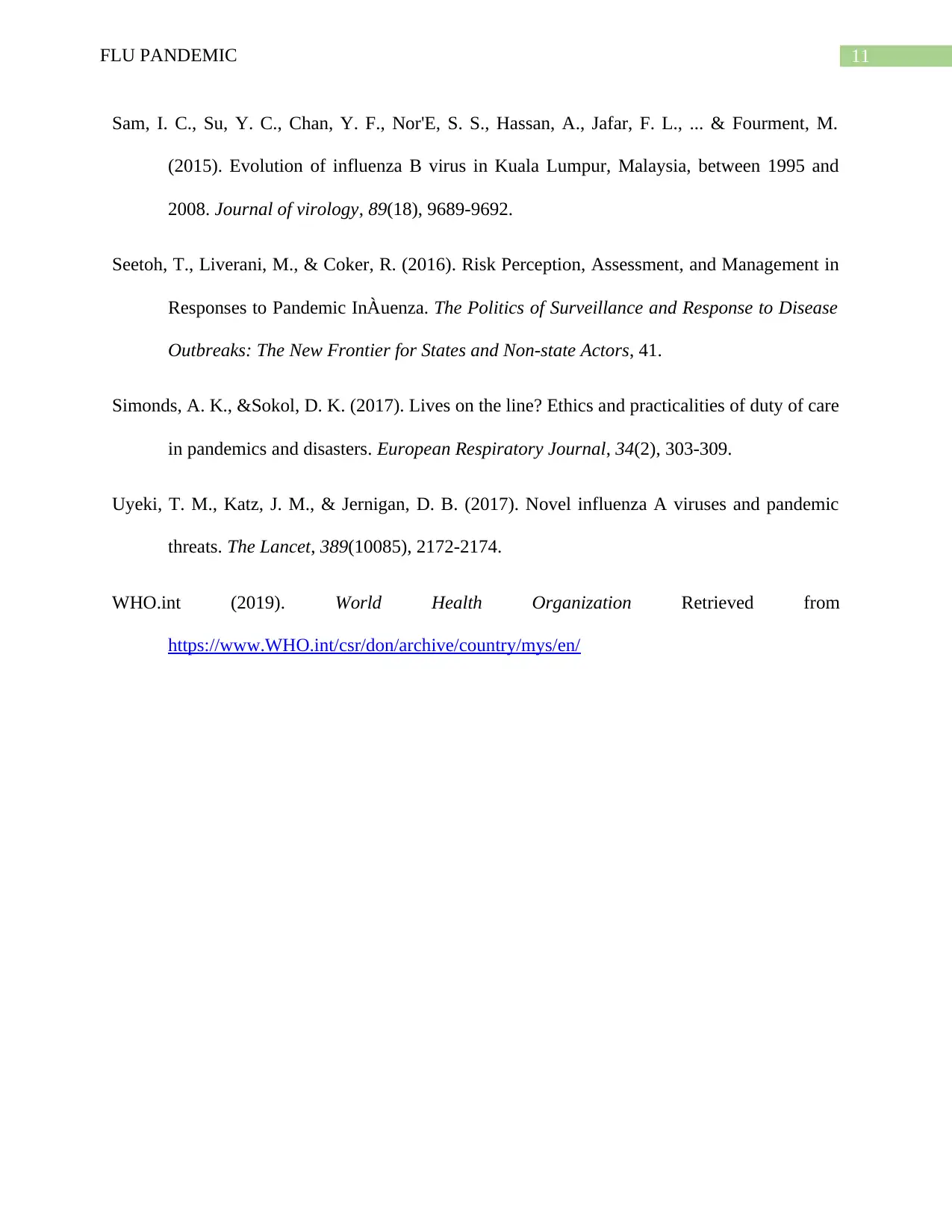
11FLU PANDEMIC
Sam, I. C., Su, Y. C., Chan, Y. F., Nor'E, S. S., Hassan, A., Jafar, F. L., ... & Fourment, M.
(2015). Evolution of influenza B virus in Kuala Lumpur, Malaysia, between 1995 and
2008. Journal of virology, 89(18), 9689-9692.
Seetoh, T., Liverani, M., & Coker, R. (2016). Risk Perception, Assessment, and Management in
Responses to Pandemic InÀuenza. The Politics of Surveillance and Response to Disease
Outbreaks: The New Frontier for States and Non-state Actors, 41.
Simonds, A. K., &Sokol, D. K. (2017). Lives on the line? Ethics and practicalities of duty of care
in pandemics and disasters. European Respiratory Journal, 34(2), 303-309.
Uyeki, T. M., Katz, J. M., & Jernigan, D. B. (2017). Novel influenza A viruses and pandemic
threats. The Lancet, 389(10085), 2172-2174.
WHO.int (2019). World Health Organization Retrieved from
https://www.WHO.int/csr/don/archive/country/mys/en/
Sam, I. C., Su, Y. C., Chan, Y. F., Nor'E, S. S., Hassan, A., Jafar, F. L., ... & Fourment, M.
(2015). Evolution of influenza B virus in Kuala Lumpur, Malaysia, between 1995 and
2008. Journal of virology, 89(18), 9689-9692.
Seetoh, T., Liverani, M., & Coker, R. (2016). Risk Perception, Assessment, and Management in
Responses to Pandemic InÀuenza. The Politics of Surveillance and Response to Disease
Outbreaks: The New Frontier for States and Non-state Actors, 41.
Simonds, A. K., &Sokol, D. K. (2017). Lives on the line? Ethics and practicalities of duty of care
in pandemics and disasters. European Respiratory Journal, 34(2), 303-309.
Uyeki, T. M., Katz, J. M., & Jernigan, D. B. (2017). Novel influenza A viruses and pandemic
threats. The Lancet, 389(10085), 2172-2174.
WHO.int (2019). World Health Organization Retrieved from
https://www.WHO.int/csr/don/archive/country/mys/en/
1 out of 12
Related Documents
Your All-in-One AI-Powered Toolkit for Academic Success.
+13062052269
info@desklib.com
Available 24*7 on WhatsApp / Email
![[object Object]](/_next/static/media/star-bottom.7253800d.svg)
Unlock your academic potential
© 2024 | Zucol Services PVT LTD | All rights reserved.





